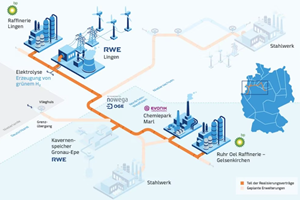News
Partners sign implementation contracts and pave the way for integrated H2 projects
In 2025, an infrastructure from Lingen to Gelsenkirchen with green H2 is expected to significantly reduce CO2 emissions from the industry. The five companies involved, bp, Evonik, Nowega, OGE and RWE, have now signed the implementation contracts as part of the GET H2 Nukleus project. The companies are thereby paving the way for the implementation of the first integrated IPCEI H2 project as part of the GET H2 initiative as well as for the connection of further projects within the framework of IPCEI funding.
The aim of the projects is to create an important starting point for the H2 economy in the Emsland, Münsterland and Ruhr area, which will emerge in Germany in the coming years and make a significant contribution to achieving the climate goals. The implementation is intended to create the basis for connecting additional producers and buyers of green H2 from industry and medium-sized businesses in the regions. This makes the building blocks of the GET H2 nucleus an important economic factor for the regions as well as for Lower Saxony and North Rhine-Westphalia. As part of the GET H2 initiative, links to several other projects have already been initiated.
The contracts that have now been signed regulate the conversion and construction of the H2 pipelines as well as the mutual rights and obligations of the contractual partners until the start of operation of the components of the GET H2 nucleus. In addition, the necessary starting points for the interaction of the project partners in the future market and the rules of the game for the already planned expansions of the system as well as the integration of further players have been created in the contracts, because the network should be available without discrimination.
“With the rules agreed in the contracts, the partners overcome the chicken-and-egg problem and can at the same time continue with the projects for the production, transport and purchase of green H2,” said the project partners. It is important that the companies involved do not suffer any disadvantages as a result of their early involvement. For implementation, a short-term notification of the requested IPCEI funding from the EU is still required. “With these contracts we create the opportunity to continue preparing the individual building blocks despite decisions still being made,” emphasize the companies involved.
H2 is to be produced using green electricity in the RWE Generation electrolysis plant in Lingen. The system on the site of the Emsland gas power plant is scheduled to go into operation in 2025 and would then be one of the first electrolyzers in the world with an output of 100 MW. An expansion to 300 MW is already planned in the following years. On the route from Lingen via the Evonik chemical park in Marl to Gelsenkirchen, existing lines from the current natural gas network from Nowega and OGE as well as existing lines from Evonik are to be converted to the transport of H2.
Shorter pipeline sections will also be built to connect generation and consumers. In the bp refineries in Gelsenkirchen and Lingen as well as in the Marl chemical park, green H2 is to be used in the production process and as a raw material to replace the gray H2 previously used, the production of which produces CO2 emissions. For the chemical industry, H2 is not primarily used to generate energy, but is particularly important as a raw material for numerous products.
A planned H2 storage facility from RWE Gas Storage West in Gronau-Epe and an electrolyzer at the bp site in Lingen are also to be connected to the network. The infrastructure of the GET H2 Nucleus also creates the basis for the implementation of additional power supplies and the connection of additional producers, buyers and important import routes.


